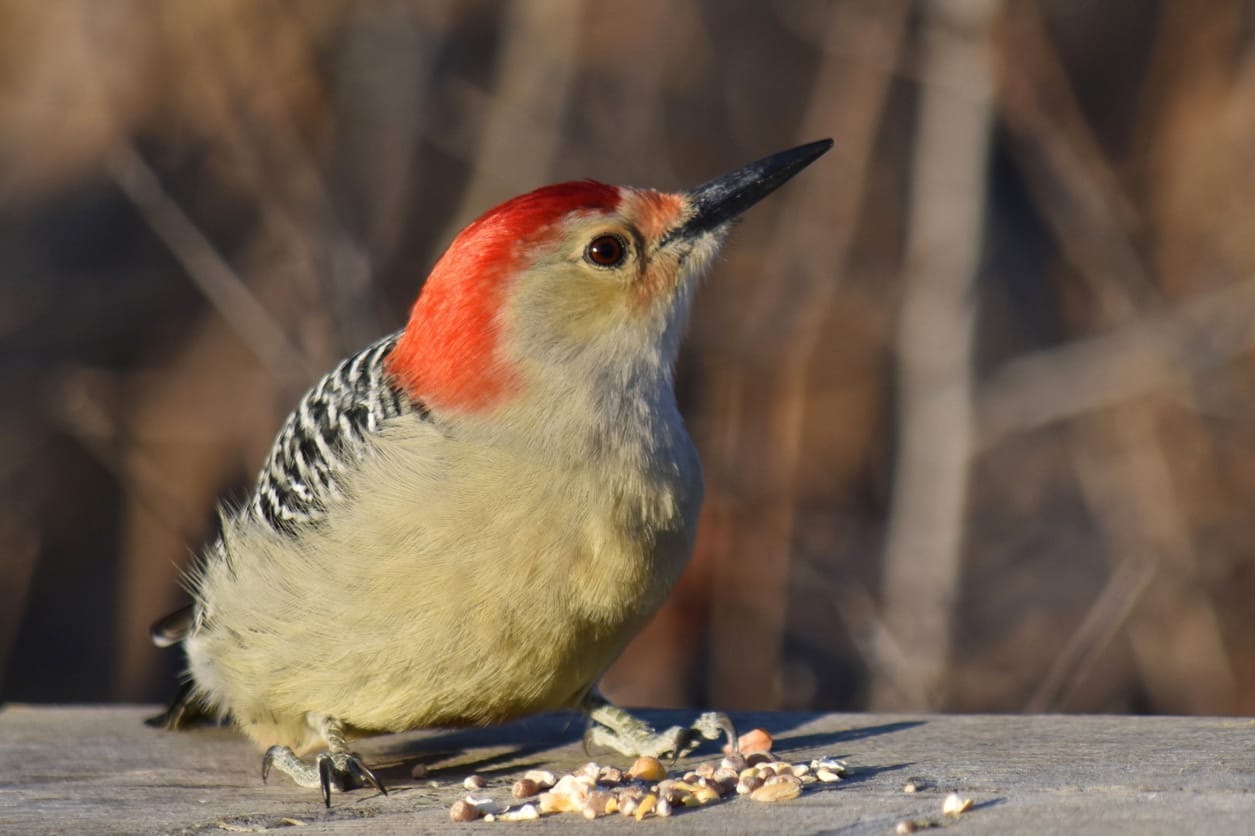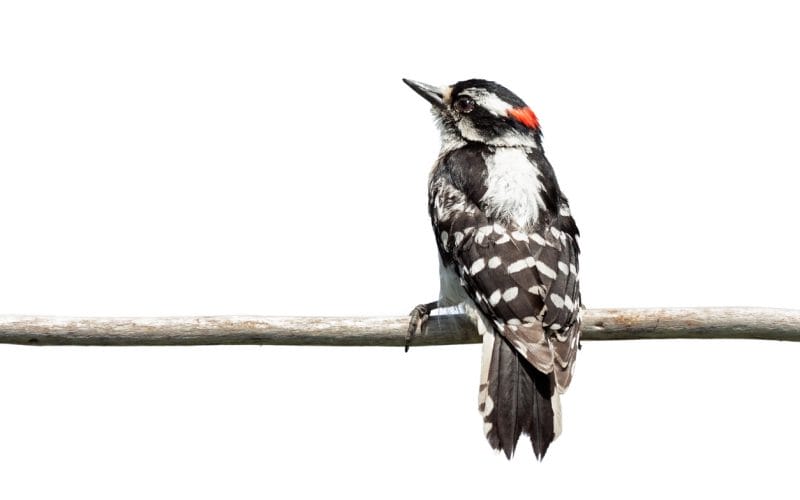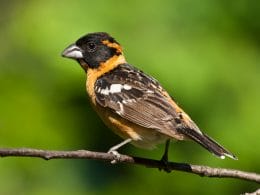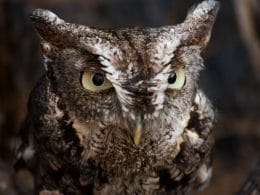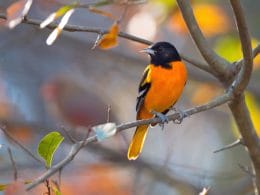New York is most notable for its grand architecture and museums. However, there’s more to New York than the famous big apple and the remarkable Statue of Liberty.
New York houses diverse wildlife and many birds due to its vast woodlands and forests. This article focuses on the woodpeckers in the State of New York, giving an overview of the appearance, diets, and characteristics of different species.
Different Species of Woodpeckers in New York
All in all, there are eleven different species of woodpeckers in New York. However, they aren’t easily spotted in the state with the same frequency. The woodpecker species of New York are:
1. The Yellow-Bellied Sapsuckers
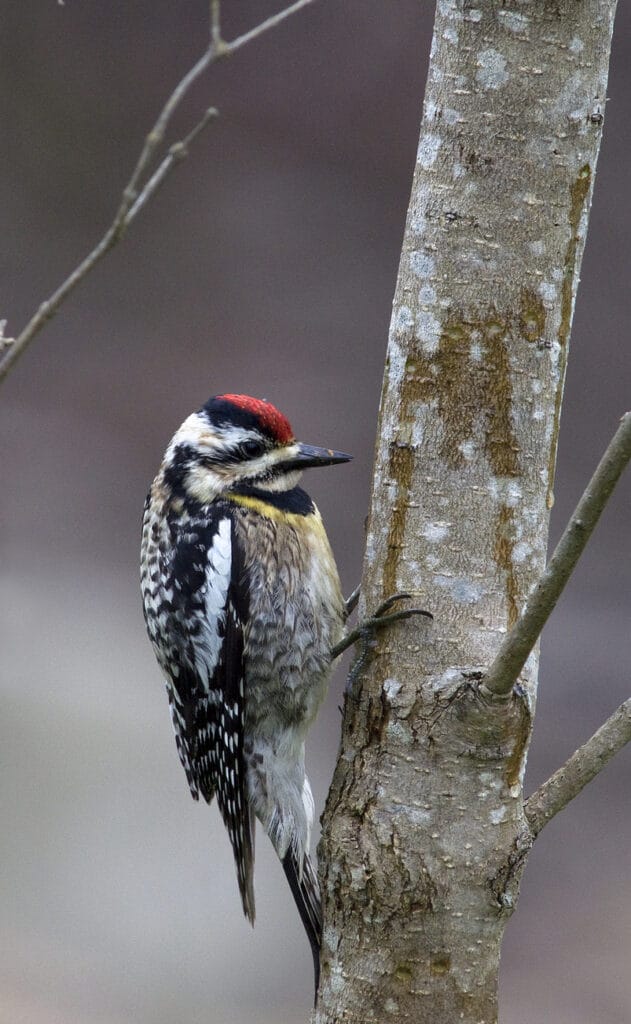
- Scientific Name: Sphyrapicus varius
- Length: 7.1-8.7 in
- Weight: 1.5-1.9 oz
- Wingspan: 13.4-15.8 in
These woodpeckers are small with long wings and short bills.
Despite its name, the Yellow-bellied Sapsucker isn’t all yellow. It’s primarily black and white with some pale yellow markings on its undersides. This bird is known for its bright red forehead, red throat, and white stripes down the sides of its neck.
Author Note: The Yellow-Bellied Sapsucker is known for its alert expression. It sometimes raises its feathers above its head in a cautious position.
This species mainly breeds in the deciduous forests of New York. If you want to spot them, look for a horizontal row of sap wells on a tree. These birds tend to dig an evenly-spaced horizontal row of little holes on trees to suck the sap out of them.
The Yellow-Bellied Sapsucker prefers certain trees, such as hickory, sugar or red maple, young paper birch, and yellow birch. They lay about five or six eggs and nest in the cavities of trees.
2. The Hairy Woodpecker
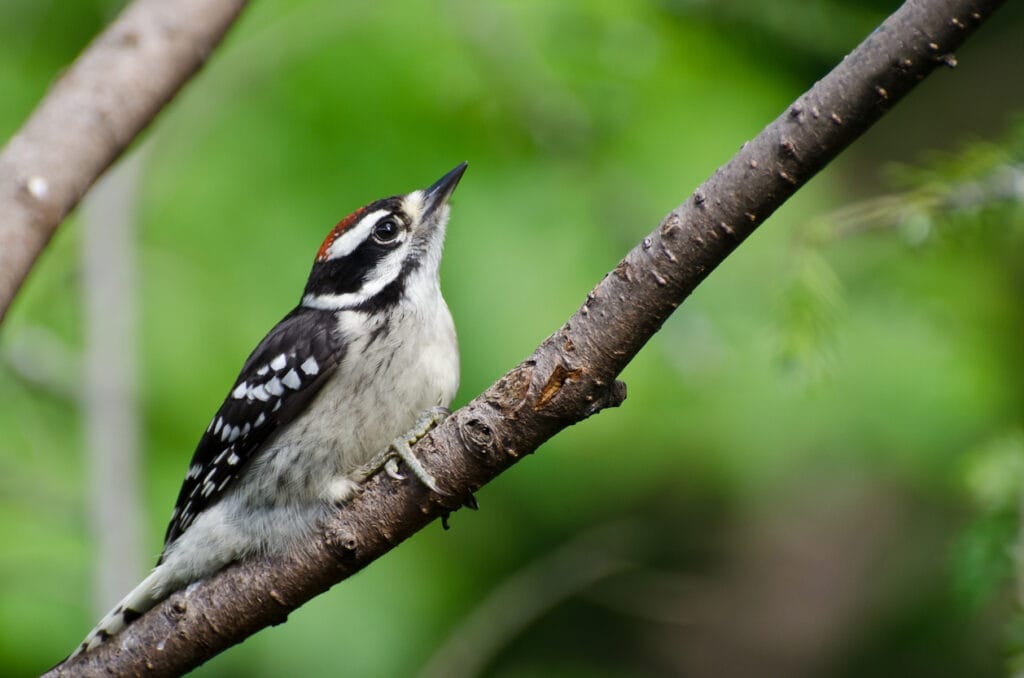
- Scientific Name: Leuconotopicus Villosus
- Length: 7.1-10.2 in
- Weight: 1.4-3.4 oz
- Wingspan: 13.0-16.1 in
The Hairy Woodpecker is a medium-sized bird that’s primarily found in New York’s woodland areas. It features a patterned black and white plumage with a large white patch on the back. The males of this species have a hint of red at the back of their heads.
This species looks like the Downy Woodpecker, except for some slight differences. For instance, the Hairy Woodpecker is larger with a longer bill. You can recognize this species through its explosive-like peak calls or powerful whinnying sound.
These birds feed mainly on the insects that live in wood, such as bark beetle larvae and ants. However, they can also consume pupae, spiders, caterpillars, bees, and millipedes.
They usually stick to tall trees to look for leftover insects or sab in the holes left behind by other species. They tend to lay from 3 to 6 eggs within the cavities of dead trees.
3. The Pileated Woodpecker

- Scientific Name: Dryocopus pileatus
- Length: 15.8-19.3 in
- Weight: 8.8-12.3 oz
- Wingspan: 26.0-29.5 in
Being the largest among all New Yorker woodpeckers, the Pileated Woodpecker is easily identifiable with the large flaming-red triangular crest on top of its head. This bird features bold white stripes down the sides of its neck with a remarkable red streak on the cheek of the adult male.
You can even identify this woodpecker by its loud shrill whine. It also creates a loud drumming noise as it pecks into trees with its long sharp bill.
This species lives mostly in the southern part of the state with its downed forests that have lots of tall dead trees. The woodpeckers will create rectangular holes, foraging for insects such as carpenter ants. In addition, they feed on wild fruit, nuts, and berries.
The Pileated Woodpecker creates a new nest every year in dead trees. They typically lay between three and five white eggs.
4. The Black-Backed Woodpecker

- Scientific Name: Picoides arcticus
- Length: 9.1 in
- Weight: 2.1-3.1 oz
- Wingspan: 15.8-16.5 in
Black-backed Woodpeckers aren’t very common. They can mostly be found in the northern part of the state. They’re small and can hardly be spotted due to their black backs that allow them to blend in with nature easily.
The Black-Backed Woodpeckers have black and white plumage with a white belly and white stripes on their sides. The adult males of this species feature a yellow cap.
Top Tip: Also known as the Arctic Three-Toed Woodpecker, this species looks like the American Three-toed woodpeckers. Not only are these birds among the rare species with three toes, but they also tend to dwell in recently burnt forests.
However, the Black-backed Woodpeckers are more dominant and louder with their sharp calls. These birds eat wood-boring beetle larvae in recently burned areas. They usually make a new nest every time to lay three or four white eggs.
5. The Northern Flicker

- Scientific Name:Colaptes auratus
- Length: 11.0-12.2 in
- Weight: 3.9-5.6 oz
- Wingspan: 16.5-20.1 in
Northern Flickers are distinctive. They usually stand out due to their different colors. Instead of the usual black and white plumage of most woodpecker species of New York, this species features a gray-brown combination.
These birds are large with slim round heads and large curved bills. They have darker streaks on their undersides and bright yellow hints on their wings and tails. They also feature a white patch on their rump and a red nape on their necks.
Unlike most other species, the Northern Flickers are usually found near the ground foraging for ants and beetles. They can also eat fruits. Northern Flickers tend to nest in tree cavities to lay between five and eight white eggs.
6. The American Three-Toed Woodpecker

- Scientific Name: Picoides dorsalis
- Length: 8.3-9.1 in
- Weight: 1.6-2.4 oz
- Wingspan: 14.6-15.3 in
American Three-Toed Woodpeckers are small birds with primarily black and white plumage and strong short bills. They also feature white underparts with fine black barrings. The adult males of this species usually have a yellow patch on their foreheads.
You can very rarely spot this bird in the state of New York, and it would usually be in the northern part of the state. However, the American Three-toed Woodpecker can easily be overlooked because it perches still for long periods on the sides of trees.
These birds dwell in recently burned or beetle-infested forests, where they mainly consume these beetle larvae in addition to eating moth pupae, ant larvae, and spiders.
7. The Red-Bellied Woodpecker
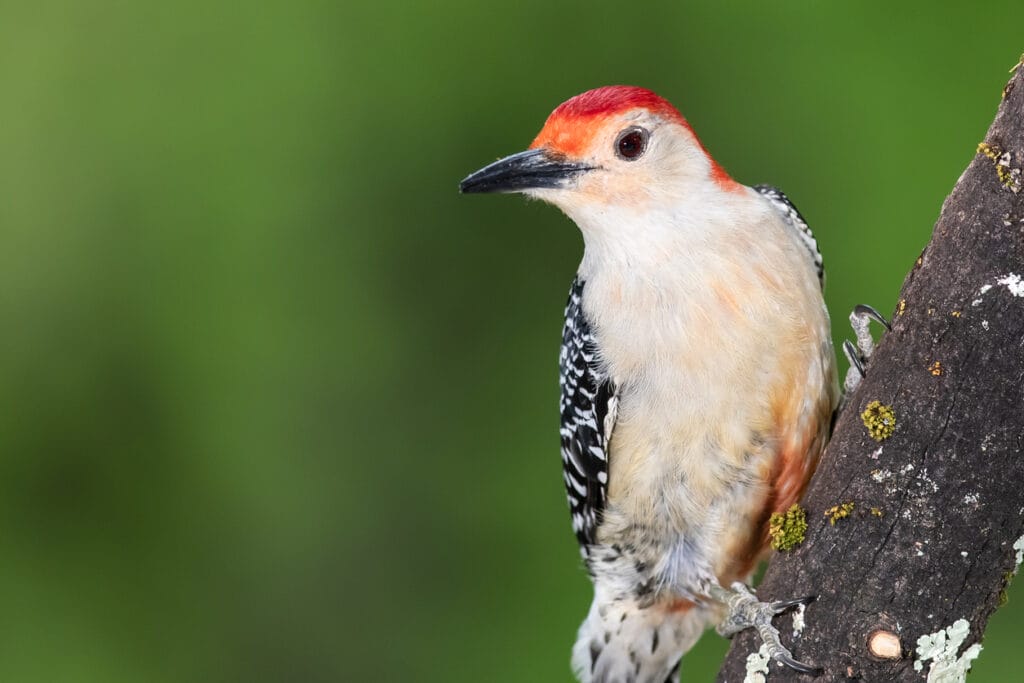
- Scientific Name: Melanerpes carolinus
- Length: 9.4 in
- Weight: 2.0-3.2 oz
- Wingspan: 13.0-16.5 in
Red-Bellied Woodpeckers have black and white overall plumage with the common markings on their backs. Despite their names, their bellies are a very pale red that can hardly be spotted. The females of this species feature a red nape without any red on their crowns.
These birds aren’t very common to spot. However, they live primarily on the western and eastern edges of the state. You can find them in groves, forests, and woodlands. They prefer places near water bodies. They are known for their rolling calls that are especially louder in spring and summer.
Author Note: Red-Bellied Woodpeckers are adaptable birds that can be spotted in urban settings. Therefore, you can attract them to your birdfeeder, especially if you live near a wooded area.
This species consumes spiders, insects, fruits, seeds from grass, and nuts. They use their very same nest for years to lay four or five white eggs over a bed of wood chips.
8. The Downy Woodpecker

- Scientific Name: Picoides pubescens
- Length: 5.5-6.7 in
- Weight: 0.7-1.0 oz
- Wingspan: 9.8-11.8 in
Downy Woodpeckers are the smallest woodpecker species in North America. They’re mostly black with distinct black and white patterns and a white patch on the back. The males of this species feature a red patch on the back of their heads.
Downy Woodpeckers are often confused with the Hairy Woodpeckers because of their distinct patterned plumage. However, they’re much smaller with smaller beaks. Moreover, unlike the hairy woodpeckers, these birds have white spots on their tail feathers.
These birds can adapt to different habitats, including urban yards, open woodlands, forest edges, and even your backyard if you provide the right attraction. They not only drill into trees like other woodpeckers but also forage in long weeds and grass.
Downy Woodpeckers are active and fun to watch. They can be spotted at bird feeders, among other birds. However, their high-pitched sound and descending whinny call distinguish them.
This species of woodpeckers nests in the cavities of dead trees and lays between 3 and 8 small white eggs. They feed principally on larvae and nuts. However, they sometimes also consume berries, grains, and acorns.
9. The Red-headed Woodpecker
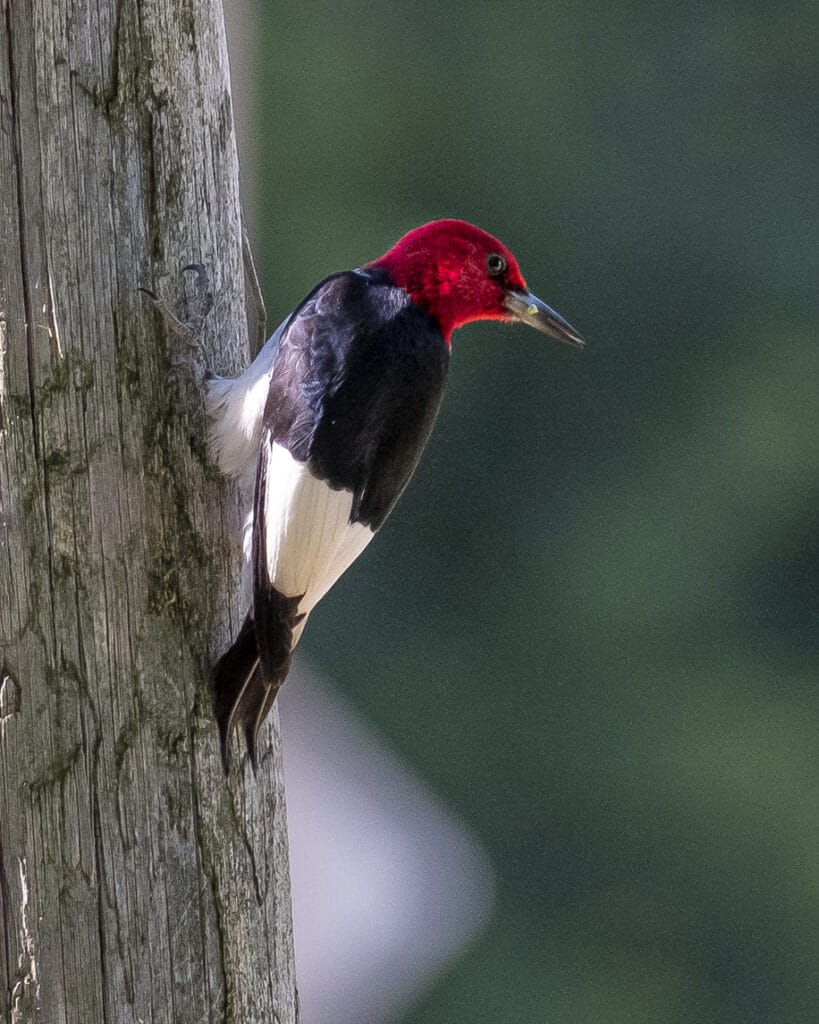
- Scientific Name: Melanerpes erythrocephalus
- Length: 7.5-9.1 in
- Weight: 2.0-3.2 oz
- Wingspan: 16.5 in
The Red-Headed Woodpeckers are medium-sized birds with strong bills, short tails, and vivid redheads. Their distinct plumage features black upper parts, bright white bellies, and wings that are half black and half white.
These birds are usually in New York to breed during the summer; then, they migrate south for the winter.
They typically live together in small colonies within different habitats, such as forest edges, woodlands with clearings, semi-open areas, farms, pine savannahs, and dead timber in swamps. You can locate these woodpeckers by their sharp “wee-ah” sounds and their deep drumming on trees.
Birds of this species don’t rely only on foraging in trees but also consume other food sources, such as wild fruits, flying insects, seeds, nuts, small rodents, and sometimes even other birds’ eggs. In fact, insects such as honeybees, midges, grasshoppers, and beetles form only one-third of this bird’s typical diet.
Top Tip: Red-headed Woodpeckers can become very fierce when defending their territories. They may remove or destroy the nestlings and eggs of other birds if necessary. These birds usually make a shrill call.
They nest in tree cavities and may even reuse other birds’ nesting sites. They also typically lay four or five eggs.
Unfortunately, there has been a sharp decrease of about 70% of the total number of the Red-Headed Woodpeckers between 1966 and 2014. This decline is mainly due to the loss of habitat.
10. Williamson’s Sapsucker

- Scientific Name: Sphyrapicus thyroideus
- Weight: 1.6-1.9 oz
- Length: 8.3-9.8 in
- Wingspan: 17 in
Williamson’s Sapsucker is a rare species in the state of New York. The males and females of this species are very distinct to the extent that they were originally classified as two separate species.
Male Williamson’s Sapsuckers feature black and white plumage with yellow bellies and red throats. On the other hand, females have black and white barred flanks and backs, a brown head, and a black band along their yellow bellies.
Birds of this species can be spotted in coniferous forests. They drill neat rows of small holes into tree barks to feed on sap. They also feed on tree tissues and insects, especially ants.
11. Lewis’s Woodpecker
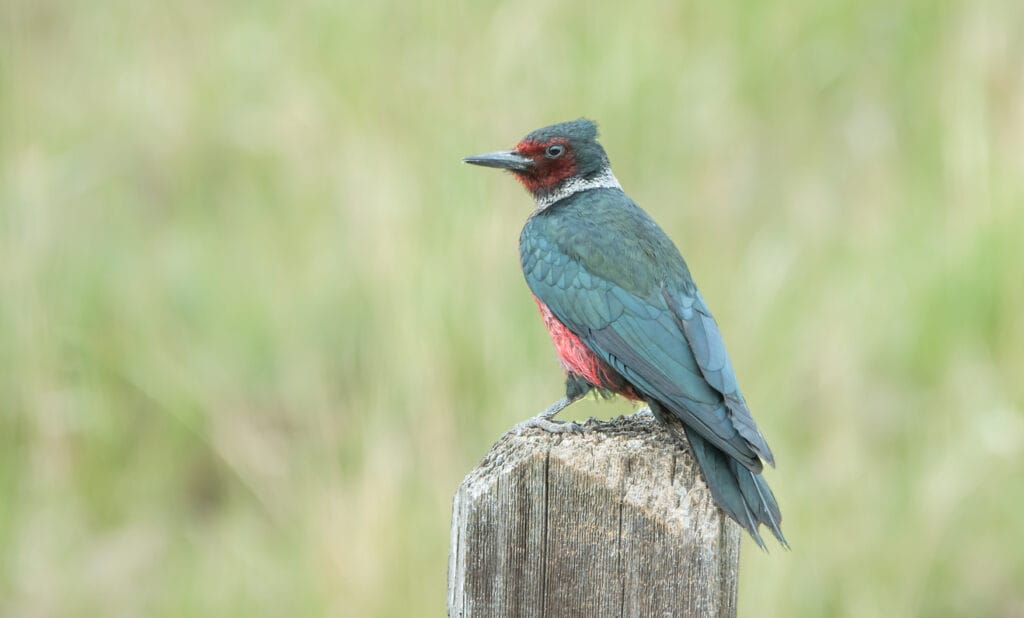
- Scientific Name: Melanerpes lewis
- Weight: 3.1-4.9 oz
- Length: 10-11 in
- Wingspan: 19.3–20.5 in
Lewis’s Woodpeckers have elongated bodies with rather long wings and tails. They feature a red face that may appear in different shades according to the lighting.
Author Note: These birds are very uncommon. However, you can spot them year-round in New York’s woodlands, burned forests, orchards, and pine forests. They typically perch high on posts, branches, and wires. They can catch insects in midflight.
To Wrap It Up
The various terrains in the state of New York are the direct reason for the presence of different species of birds, such as woodpeckers.
In New York, you can spot up to eleven different woodpecker species. Among these species are the sapsuckers, such as Williamson’s and the Yellow-bellied sapsuckers.
The smallest woodpecker in New York and North America is the Downy Woodpecker, while the largest is the Pileated Woodpecker.
Other woodpecker species in the state of New York are Lewis’s Woodpeckers, the Red-Headed Woodpeckers, the Red-Bellied Woodpeckers, the Black-Backed Woodpeckers, the Northern Flicker, the American Three-Toed Woodpeckers, and the Hairy Woodpecker.
FAQ
Audubon only has 1 place listed as good for woodpeckers – Adirondack Park. However, it is a good place to look for the rare Black-backed Woodpecker.
The Red-Bellied Woodpecker is probably the most recognizable and often seen woodpecker in the state of New York.
To find out where recent sightings of woodpecker have been, try eBird. You can search for the latest sightings or particular species or what has been seen in a certain area.




